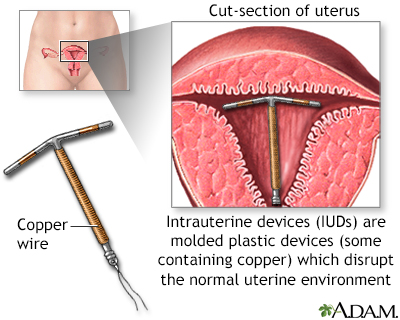Deciding about an IUD
An intrauterine device (IUD) is a small, plastic, T-shaped device used for birth control. It is inserted into the uterus where it stays to prevent pregnancy.
Images

Alternative names
Contraception - IUD; Birth control - IUD; Intrauterine - deciding; Mirena - deciding; ParaGard - deciding
Types of IUDs
You have choices for what type of IUD to have. Talk with your health care provider about which type may be best for you.
Copper-releasing IUDs:
- Start working immediately after being inserted.
- Work by releasing copper ions. These are toxic to sperm. The T-shape also blocks sperm and keeps them from reaching the egg.
- Can stay in the uterus for up to 10 years.
- Can also be used for emergency contraception.
Progestin-releasing IUDs:
- Start to work within 7 days after being inserted.
- Work by releasing progestin. Progestin is a hormone used in many kinds of birth control pills. It prevents the ovaries from releasing an egg.
- Have a T-shape that also blocks the sperm and keeps sperm from reaching an egg.
- Are FDA approved to stay in the uterus for 3 to 8 years. How long depends on the brand. There are 3 brands with different hormone dosages available in the United States: Skyla, Jaydess and Mirena. Mirena can also treat heavy menstrual bleeding and reduce cramps. A fourth brand, Levosert, similar to Mirena, is also available.
How IUDs work
Both types of IUDs prevent sperm from fertilizing an egg.
Progestin-releasing IUDs also works by:
- Making the mucus around the cervix thicker, which makes it harder for sperm get inside the uterus and fertilize an egg
- Thinning the lining of the uterus, which makes it more difficult for a fertilized egg to attach
Pros and cons
IUDs have certain benefits.
- They are more than 99% effective at preventing pregnancy.
- You don't need to think about birth control each time you have sex.
- One IUD can last for 3 to 10 years. This makes it one of the cheapest forms of birth control.
- You become fertile again almost immediately after an IUD is removed.
- Copper-releasing IUDs do not have hormonal side effects and may help protect against uterine (endometrial) cancer.
- Both types of IUDs may lower the risk of developing cervical cancer.
There are also downsides.
- IUDs do not prevent sexually transmitted diseases (STDs). To avoid STDs you need to abstain from sex, be in a mutually monogamous relationship, or use condoms.
- A provider needs to insert or remove the IUD.
- While rare, an IUD can slip out of place and need to be removed.
- Copper-releasing IUDs can cause cramps, longer and heavier menstrual periods, and spotting between periods.
- Progestin-releasing IUDs can cause irregular bleeding and spotting during the first few months.
- IUDs may increase the risk for ectopic pregnancy. But women who use IUDs have a very low risk of getting pregnant.
- Some types of IUDs may increase the risk for benign ovarian cysts. But such cysts usually do not cause symptoms and they usually resolve on their own.
IUDs do not appear to increase the risk for pelvic infection. They also do not affect fertility or increase the risk for infertility. Once an IUD is removed, fertility is restored.
Things to think about
You may want to consider an IUD if you:
- Want or need to avoid risks for contraceptive hormones
- Can't take hormonal contraceptives
- Have a heavy menstrual flow and want lighter periods (hormonal IUD only)
You should not consider an IUD if you:
- Are at high risk for STDs
- Have a current or recent history of pelvic infection
- Are pregnant
- Have abnormal Pap tests
- Have cervical or uterine cancer
- Have a very large or very small uterus
References
Gilner JB, Rhee EHJ, Padro A, Kuller JA. Reproductive genetics. In: Gershenson DM, Lentz GM, Valea FA, Lobo RA, eds. Comprehensive Gynecology. 8th ed. Philadelphia, PA: Elsevier; 2022:chap 2.
Jatlaoui TC, Riley HEM, Curtis KM. The safety of intrauterine devices among young women: a systematic review. Contraception. 2017;95(1):17-39. PMID: 27771475 pubmed.ncbi.nlm.nih.gov/27771475/.
Schreiber CA, Barnhart K. Contraception. In: Strauss JF, Barbieri RL, eds. Yen & Jaffe's Reproductive Endocrinology. 8th ed. Elsevier; 2019:chap 36.
Winikoff B, Grossman D. Contraception. In: Goldman L, Schafer AI, eds. Goldman-Cecil Medicine. 26th ed. Philadelphia, PA: Elsevier; 2020:chap 225.
BACK TO TOPReview Date: 11/10/2022
Reviewed By: John D. Jacobson, MD, Department of Obstetrics and Gynecology, Loma Linda University School of Medicine, Loma Linda, CA. Also reviewed by David C. Dugdale, MD, Medical Director, Brenda Conaway, Editorial Director, and the A.D.A.M. Editorial team.

Health Content Provider
06/01/2025
|
A.D.A.M., Inc. is accredited by URAC, for Health Content Provider (www.urac.org). URAC's accreditation program is an independent audit to verify that A.D.A.M. follows rigorous standards of quality and accountability. A.D.A.M. is among the first to achieve this important distinction for online health information and services. Learn more about A.D.A.M.'s editorial policy, editorial process and privacy policy. A.D.A.M. is also a founding member of Hi-Ethics. This site complied with the HONcode standard for trustworthy health information from 1995 to 2022, after which HON (Health On the Net, a not-for-profit organization that promoted transparent and reliable health information online) was discontinued. |
The information provided herein should not be used during any medical emergency or for the diagnosis or treatment of any medical condition. A licensed medical professional should be consulted for diagnosis and treatment of any and all medical conditions. Links to other sites are provided for information only -- they do not constitute endorsements of those other sites. © 1997- 2024 A.D.A.M., a business unit of Ebix, Inc. Any duplication or distribution of the information contained herein is strictly prohibited.
